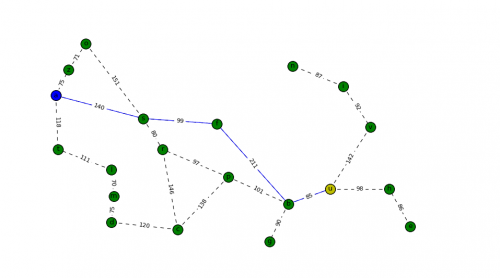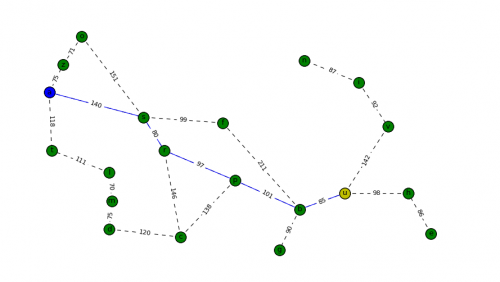Двунаправленный A * не нахождение кратчайшего пути
Я реализую двунаправленный алгоритм A* в Python 2.7.12 и тестирую его на карте Румынии от Рассела и Норвига, Глава 3. Ребра имеют веса, и цель состоит в том, чтобы найти кратчайший путь между двумя узлами.
Вот визуализация графика тестирования:
Пример, где мое двунаправленное A* терпит неудачу, - это то, где отправной точкой является 'a', а целью является 'u'. Это путь, который имеет моя реализация найдено:
 Длина
Длина ['a', 's', 'f', 'b', 'u'] равна 535.
Это самый короткий путь от 'a' до 'u':
 Длина
Длина ['a', 's', 'r', 'p', 'b', 'u'] равна 503.
Это скрипт python с моей реализацией A* (я использовал евклидово расстояние в качестве эвристики) и несколькими другими классами справки и функции:
from __future__ import division
import math
from networkx import *
import random
import pickle
import sys
import heapq
import matplotlib.pyplot as plt
class PriorityQueue():
"""Implementation of a priority queue"""
def __init__(self):
self.queue = []
self.node_finder = dict()
self.current = 0
self.REMOVED_SYMBOL = '<removed>'
def next(self):
if self.current >=len(self.queue):
self.current
raise StopIteration
out = self.queue[self.current]
self.current += 1
return out
def pop(self):
while self.queue:
node = heapq.heappop(self.queue)
nodeId = node[1]
if nodeId is not self.REMOVED_SYMBOL:
try:
del self.node_finder[nodeId]
except KeyError:
dummy=1
return node
def remove(self, nodeId):
node = self.node_finder[nodeId]
node[1] = self.REMOVED_SYMBOL
def __iter__(self):
return self
def __str__(self):
return 'PQ:[%s]'%(', '.join([str(i) for i in self.queue]))
def append(self, node):
nodeId = node[1]
nodePriority = node[0]
node = [nodePriority, nodeId]
self.node_finder[nodeId] = node
heapq.heappush(self.queue, node)
def update(self, node):
nodeId = node[1]
nodePriority = node[0]
node = [nodePriority, nodeId]
self.remove(nodeId)
self.node_finder[nodeId] = node
heapq.heappush(self.queue, node)
def getPriority(self, nodeId):
return self.node_finder[nodeId][0]
def __contains__(self, key):
self.current = 0
return key in [n for v,n in self.queue]
def __eq__(self, other):
return self == other
def size(self):
return len(self.queue)
def clear(self):
self.queue = []
def top(self):
return self.queue[0]
__next__ = next
def bidirectional_a_star(graph, start, goal):
if start == goal:
return []
pq_s = PriorityQueue()
pq_t = PriorityQueue()
closed_s = dict()
closed_t = dict()
g_s = dict()
g_t = dict()
g_s[start] = 0
g_t[goal] = 0
cameFrom1 = dict()
cameFrom2 = dict()
def euclidean_distance(graph, v, goal):
xv, yv = graph.node[v]['pos']
xg, yg = graph.node[goal]['pos']
return ((xv-xg)**2 + (yv-yg)**2)**0.5
def h1(v): # heuristic for forward search (from start to goal)
return euclidean_distance(graph, v, goal)
def h2(v): # heuristic for backward search (from goal to start)
return euclidean_distance(graph, v, start)
cameFrom1[start] = False
cameFrom2[goal] = False
pq_s.append((0+h1(start), start))
pq_t.append((0+h2(goal), goal))
done = False
i = 0
mu = 10**301 # 10**301 plays the role of infinity
connection = None
while pq_s.size() > 0 and pq_t.size() > 0 and done == False:
i = i + 1
if i % 2 == 1: # alternate between forward and backward A*
fu, u = pq_s.pop()
closed_s[u] = True
for v in graph[u]:
weight = graph[u][v]['weight']
if v in g_s:
if g_s[u] + weight < g_s[v]:
g_s[v] = g_s[u] + weight
cameFrom1[v] = u
if v in closed_s:
del closed_s[v]
if v in pq_s:
pq_s.update((g_s[v]+h1(v), v))
else:
pq_s.append((g_s[v]+h1(v), v))
else:
g_s[v] = g_s[u] + weight
cameFrom1[v] = u
pq_s.append((g_s[v]+h1(v), v))
if v in closed_t:
if g_s[u] + weight + g_t[v] < mu:
mu = g_s[u] + weight + g_t[v]
connection = v
done = True
else:
fu, u = pq_t.pop()
closed_t[u] = True
for v in graph[u]:
weight = graph[u][v]['weight']
if v in g_t:
if g_t[u] + weight < g_t[v]:
g_t[v] = g_t[u] + weight
cameFrom2[v] = u
if v in closed_t:
del closed_t[v]
if v in pq_t:
pq_t.update((g_t[v]+h2(v), v))
else:
pq_t.append((g_t[v]+h2(v), v))
else:
g_t[v] = g_t[u] + weight
cameFrom2[v] = u
pq_t.append((g_t[v]+h2(v), v))
if v in closed_s:
if g_t[u] + weight + g_s[v] < mu:
mu = g_t[u] + weight + g_s[v]
connection = v
done = True
if u in closed_s and u in closed_t:
if g_s[u] + g_t[u] < mu:
mu = g_s[u] + g_t[u]
connection = u
stopping_distance = min(min([f for (f,x) in pq_s]), min([f for (f,x) in pq_t]))
if mu <= stopping_distance:
done = True
#connection = u
continue
if connection is None:
# start and goal are not connected
return None
#print cameFrom1
#print cameFrom2
path = []
current = connection
#print current
while current != False:
#print predecessor
path = [current] + path
current = cameFrom1[current]
current = connection
successor = cameFrom2[current]
while successor != False:
path = path + [successor]
current = successor
successor = cameFrom2[current]
return path
# This function visualizes paths
def draw_graph(graph, node_positions={}, start=None, goal=None, path=[]):
explored = list(graph.get_explored_nodes())
labels ={}
for node in graph:
labels[node]=node
if not node_positions:
node_positions = networkx.spring_layout(graph)
edge_labels = networkx.get_edge_attributes(graph,'weight')
networkx.draw_networkx_nodes(graph, node_positions)
networkx.draw_networkx_edges(graph, node_positions, style='dashed')
networkx.draw_networkx_edge_labels(graph, node_positions, edge_labels=edge_labels)
networkx.draw_networkx_labels(graph,node_positions, labels)
networkx.draw_networkx_nodes(graph, node_positions, nodelist=explored, node_color='g')
if path:
edges = [(path[i], path[i+1]) for i in range(0, len(path)-1)]
networkx.draw_networkx_edges(graph, node_positions, edgelist=edges, edge_color='b')
if start:
networkx.draw_networkx_nodes(graph, node_positions, nodelist=[start], node_color='b')
if goal:
networkx.draw_networkx_nodes(graph, node_positions, nodelist=[goal], node_color='y')
plt.plot()
plt.show()
# this function calculates the length of the path
def calculate_length(graph, path):
pairs = zip(path, path[1:])
return sum([graph.get_edge_data(a, b)['weight'] for a, b in pairs])
#Romania map data from Russell and Norvig, Chapter 3.
romania = pickle.load(open('romania_graph.pickle', 'rb'))
node_positions = {n: romania.node[n]['pos'] for n in romania.node.keys()}
start = 'a'
goal = 'u'
path = bidirectional_a_star(romania, start, goal)
print "This is the path found by bidirectional A* :", path
print "Its length :", calculate_length(romania, path)
# visualize my path
draw_graph(romania, node_positions=node_positions, start=start, goal=goal, path=path)
# compare to the true shortest path between start and goal
true_path = networkx.shortest_path(romania, start, goal, weight='weight')
print "This is the actual shortest path: ", true_path
print "Its lenght: ", calculate_length(romania, true_path)
#visualize true_path
draw_graph(romania, node_positions=node_positions, start=start, goal=goal, path=true_path)
Данные Pickle для Румынии можно загрузить изздесь .
1 ответ:
Я исправил некоторые ошибки в
PriorityQueueиbidirectional_a_star. Теперь все работает нормально.Исправленный код для класса и функции выглядит следующим образом:
class PriorityQueue(): """Implementation of a priority queue""" def __init__(self): self.queue = [] self.node_finder = dict() self.current = 0 self.REMOVED_SYMBOL = '<removed>' def next(self): if self.current >=len(self.queue): self.current raise StopIteration out = self.queue[self.current] while out == self.REMOVED_SYMBOL: self.current += 1 out = self.queue[self.current] self.current += 1 return out def pop(self): # TODO: finish this while self.queue: node = heapq.heappop(self.queue) nodeId = node[1] if nodeId is not self.REMOVED_SYMBOL: try: del self.node_finder[nodeId] except KeyError: dummy=1 return node #raise KeyError('pop from an empty priority queue') def remove(self, nodeId): node = self.node_finder[nodeId] node[1] = self.REMOVED_SYMBOL def __iter__(self): return self def __str__(self): return 'PQ:[%s]'%(', '.join([str(i) for i in self.queue])) def append(self, node): # node = (priority, nodeId) nodeId = node[1] nodePriority = node[0] node = [nodePriority, nodeId] self.node_finder[nodeId] = node heapq.heappush(self.queue, node) def update(self, node): nodeId = node[1] nodePriority = node[0] node = [nodePriority, nodeId] self.remove(nodeId) self.node_finder[nodeId] = node heapq.heappush(self.queue, node) def getPriority(self, nodeId): return self.node_finder[nodeId][0] def __contains__(self, key): self.current = 0 return key in [n for v,n in self.queue] def __eq__(self, other): return self == other def size(self): return len([1 for priority, node in self.queue if node!=self.REMOVED_SYMBOL]) def clear(self): self.queue = [] def top(self): return self.queue[0] __next__ = next def bidirectional_a_star(graph, start, goal): if start == goal: return [] pq_s = PriorityQueue() pq_t = PriorityQueue() closed_s = dict() closed_t = dict() g_s = dict() g_t = dict() g_s[start] = 0 g_t[goal] = 0 cameFrom1 = dict() cameFrom2 = dict() def euclidean_distance(graph, v, goal): xv, yv = graph.node[v]['pos'] xg, yg = graph.node[goal]['pos'] return ((xv-xg)**2 + (yv-yg)**2)**0.5 def h1(v): # heuristic for forward search (from start to goal) return euclidean_distance(graph, v, goal) def h2(v): # heuristic for backward search (from goal to start) return euclidean_distance(graph, v, start) cameFrom1[start] = False cameFrom2[goal] = False pq_s.append((0+h1(start), start)) pq_t.append((0+h2(goal), goal)) done = False i = 0 mu = 10**301 # 10**301 plays the role of infinity connection = None while pq_s.size() > 0 and pq_t.size() > 0 and done == False: i = i + 1 if i % 2 == 1: # alternate between forward and backward A* fu, u = pq_s.pop() closed_s[u] = True for v in graph[u]: weight = graph[u][v]['weight'] if v in g_s: if g_s[u] + weight < g_s[v]: g_s[v] = g_s[u] + weight cameFrom1[v] = u if v in closed_s: del closed_s[v] if v in pq_s: pq_s.update((g_s[v]+h1(v), v)) else: pq_s.append((g_s[v]+h1(v), v)) else: g_s[v] = g_s[u] + weight cameFrom1[v] = u pq_s.append((g_s[v]+h1(v), v)) else: fu, u = pq_t.pop() closed_t[u] = True for v in graph[u]: weight = graph[u][v]['weight'] if v in g_t: if g_t[u] + weight < g_t[v]: g_t[v] = g_t[u] + weight cameFrom2[v] = u if v in closed_t: del closed_t[v] if v in pq_t: pq_t.update((g_t[v]+h2(v), v)) else: pq_t.append((g_t[v]+h2(v), v)) else: g_t[v] = g_t[u] + weight cameFrom2[v] = u pq_t.append((g_t[v]+h2(v), v)) if u in closed_s and u in closed_t: if g_s[u] + g_t[u] < mu: mu = g_s[u] + g_t[u] connection = u try: stopping_distance = max(min([f for (f,x) in pq_s]), min([f for (f,x) in pq_t])) except ValueError: continue if mu <= stopping_distance: done = True connection = u continue if connection is None: # start and goal are not connected return None #print cameFrom1 #print cameFrom2 path = [] current = connection #print current while current != False: #print predecessor path = [current] + path current = cameFrom1[current] current = connection successor = cameFrom2[current] while successor != False: path = path + [successor] current = successor successor = cameFrom2[current] return path
